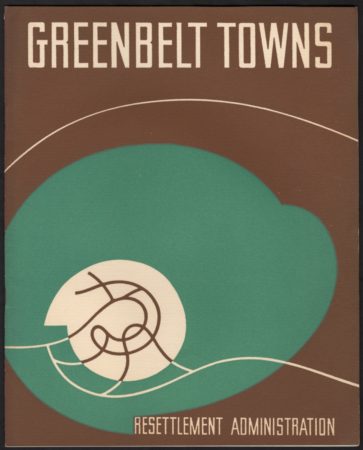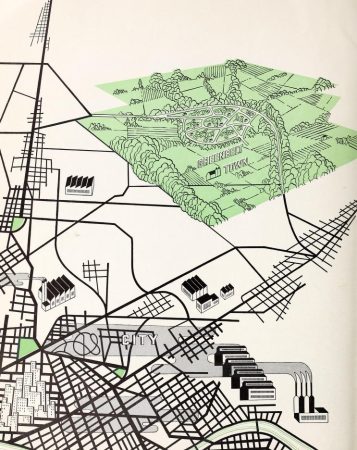The Greenbelt towns were the brainchild of Rexford Guy Tugwell, an economist who served as President Franklin D. Roosevelt’s Undersecretary of Agriculture in 1934 and 1935. A policy advisor to President Roosevelt, Tugwell believed that he could effectively combat the Depression-era issues of both poverty and homelessness in one policy—hiring unemployed men to build towns of government-owned homes that could, in turn, be leased to Americans who were otherwise struggling to afford housing.
Tugwell was largely inspired the Garden City Movement, based on the work of Ebenezer Howard. Howard, an urban planner from London, felt as though the quality of life in urban areas had been largely dwindling due to the overcrowding and congestion brought on by the Industrial Revolution. His solution was the establishment of “garden cities,” small, planned cities that could bring the amenities and convenience of urban life together with the accessibility to nature found in rural areas. Tugwell wanted to utilize Howard’s garden city framework to create utopian towns across the United States, located close enough to cities to allow residents to seize urban economic opportunities, but far enough removed to allow them to commune with nature. These towns would be surrounded by woods, parks, and other natural green spaces and feature interconnected walking paths to easily connect people’s residences to public amenities such as community centers, tennis courts, and libraries.


President Roosevelt was convinced that the Greenbelt initiative could succeed, and that the federal government needed to do more to assist struggling Americans with accessing quality housing. By Executive Order 7027, signed on April 30th, 1935, Roosevelt established the Resettlement Administration (RA), charged with resettling struggling families from both rural and urban places to suburban areas for a higher quality of life. He appointed Rexford Tugwell to serve as the RA’s administrator thereby granting Tugwell the authority needed to bring the Greenbelt towns into reality.
Tugwell’s Greenbelt initiative was initially allowed to select three sites. Decisions as to where to establish these first three sites were largely motivated by economic and demographic factors; the Resettlement Administration sought to establish these towns close to major industrial centers with large populations working in manufacturing and similar industries who could be recruited and employed in building the towns. Under this rationale, the RA selected sites outside three major industrial hubs in Washington D.C., Cincinnati, and Milwaukee, thus creating Greenbelt, Maryland; Greenhills, Ohio; and Greendale, Wisconsin. Siting, planning, and building of Greendale began in early 1936.
While President Roosevelt was convinced of the idea, the same could not be said for the more conservative members of the American legislature. Conservative legislators accused Tugwell, who they subsequently nicknamed “Rex the Red”, of being a Communist operative intent on cluttering the country with government-owned housing complexes funded by the American people’s already-empty pocketbooks—a lofty accusation and an example of the lingering anxieties following the the first Red Scare, a period of widespread fear of the spread of socialism that emerged during and in the aftermath of the World War I. Political attacks such as these, and the onset of World War II in 1939 ultimately thwarted Tugwell’s ambition to build Greenbelt towns across the country, but the original three towns were completed in the late 1930s and all continue today.
Greenbelt, Greenhills, and Greendale have all since received Department of the Interior recognition as National Historic Landmarks, and serve as ongoing representations of the unique political and economic landscape of the 1930s in the United States. The Greenbelt initiative was made possible, and subsequently shut down by, the unique circumstances of the time. The Greenbelt initiative and the idea of federally planned, built, and funded “green cities” represent a wholly unique chapter in Wisconsin and United States history. Stepping into Greendale is a step into history itself; a snapshot of the New Deal right in Milwaukee’s backyard.
Written by Evie Sellers, August 2024.
Sources:
Sherry Ahrentzen, “Greendale,” Encyclopedia of Milwaukee. Accessed April 2024. https://emke.uwm.edu/entry/greendale/.
Lindsey Anderson Rios, “The Unusual History of the Village of Greendale.” Milwaukee Magazine, 27 May 2021. https://www.milwaukeemag.com/the-unusual-history-of-the-village-of-greendale/.
“Garden City,” Encyclopedia of Britannica. Accessed December 2023. https://www.britannica.com/topic/garden-city-urban-planning/.
Franklin D. Roosevelt, “Executive Order 7027—Establishment of the Resettlement Administration.” 30 April 1935. The American Presidency Project. https://www.presidency.ucsb.edu/node/208623/







